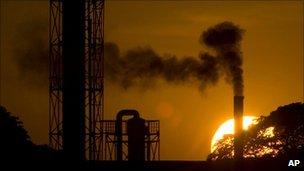Benefit to cutting 'black carbon'
- Published

Cutting short-lived emissions could have tangible benefits, says the report
Cutting atmospheric soot, methane and ground-level ozone is the quickest way to tackle climate change in the short term, according to a new report.
The governing council of the UN Environment Programme (Unep) in Nairobi will hear that reducing these short-lived emissions could reduce warming by half a degree.
And it would be more easily achieved than reducing emissions of the gas principally implicated in long-term climate change, CO2.
It would also have spin-off benefits because soot and ground-level ozone harm human health - and ozone damages crops.
Loss adjustment
The assessment comes from Unep and World Meteorological Organization, in collaboration with a global team of scientists.
Its authors insist that nations must continue to strive to reduce CO2 emissions, which will continue to warm the atmosphere for more than 100 years from the time they are produced.
But it says that using existing technologies and institutions to cut ozone and black carbon (soot) can halve regional warming for 30 to 60 years whilst averting millions of premature deaths and avoiding tens of billions of dollars of crop losses annually.
Black carbon comes from the incomplete combustion of fossil fuels, mostly through diesel engines and biomass burning - including in cook stoves and brick kilns.
It heats the atmosphere directly and also increases warming when particles fall on to snow and ice and reduce their reflectivity.
Ozone in the upper atmosphere protects us from harmful rays. At ground level it is a serious pollutant formed by the action of sunlight on methane, carbon monoxide, volatile organic compounds and oxides of nitrogen.
Methane recovery
The report says: "A small number of emission reduction measures targeting black carbon and ozone precursors could immediately begin to protect climate, public health, water and food security, and ecosystems.
"They include the recovery of methane from coal, oil and gas extraction and transport, methane capture in waste management, use of clean-burning stoves for residential cooking, diesel particulate filters for vehicles and the banning of field burning of agricultural waste."
It says the task of reducing these gases needs strategic investment and institutional plans and continues: "The identified measures complement but do not replace anticipated carbon dioxide reduction measures.
"Major CO2 reduction strategies mainly target the energy and large industrial sectors and therefore would not necessarily result in significant reductions in emissions of black carbon or the ozone precursors methane and carbon monoxide.
"Significant reduction of the short-lived climate forcers requires a specific strategy, as many are emitted from a large number of small sources.
It has been known for several years that non-CO2 gases are important short-term climate forcers but the impetus to control them was boosted by a paper in Nature Geoscience in April 2009.
A model by Drew Shindell from Nasa's Goddard Institute for Space Studies suggested that 45% or more of the Arctic warming over the past 30 years was likely to have been caused by changes in black carbon and sulphate aerosol particles.
International strategy
There have been attempts to include short-lived forcing agents into the on-going UN climate talks but although methane is included in the basket of gases to be controlled by rich nations, other ozone precursors and black carbon have been kept out of the talks on the grounds that negotiations are quite complicated enough.
Unep envisages that strategies to tackle the short-lived forcers could be possibly tackled under regional pollution agreements without the need for a global deal.
But some experts still argue that including these pollutants in UN talks would be a benefit.
Dr Mike McCracken, chief scientist for the US NGO The Climate Institute told BBC News: "Most of the emissions on these short-term warming agents are coming from developing countries.
"Most governments want to cut the emissions anyway because of the health of their people and their crops. But because the pollutants aren't included in the climate talks, the developing countries can't get any credit for cutting them.
"We have to credit them in the climate talks for creating a global benefit as well as a regional benefit."
Durwood Zaelke, President of the Institute for Governance & Sustainable Development said: "We also have to start now with aggressive cuts in CO2 if we want to win the longer term climate battle. But it's not one or the other - we need to cut both CO2 and the other climate forcing agents.
"This assessment makes clear that cutting CO2 now will not reduce warming in the next 20-30 years. This means passing the 2C level several decades earlier if we don't reduce these local air pollutants."
The latest UNEP initiative runs in parallel with another initiative to use the Montreal Protocol on ozone-depleting substances to phase down hydrofluorocarbons, which are also other powerful climate forcers.
Professor David Fowler from the Centre for Ecology and Hydrology in Midlothian told BBC News that the role of ground level ozone was particularly pernicious as ozone pollution was slowing the growth of plants which would otherwise be absorbing CO2 emissions.
"Many countries have introduced controls for the ozone precursors. These have helped knock the peaks off ozone concentrations in the UK, but during the last 20 years the tropospheric background ozone has been growing steadily...and is often in the UK spring close to or in excess of values which effect vegetation."
In other words, people and crops in the UK are suffering from ground-level ozone pollution provoked by the emission of gases somewhere else in the northern hemisphere.
"The effects of tropospheric ozone on the carbon cycle are similar in magnitude (in radiative terms) to its effects as a greenhouse gas," Professor Fowler said.
"This background pollution requires hemispheric scale control measures."